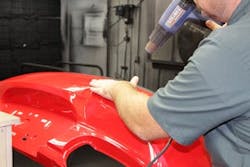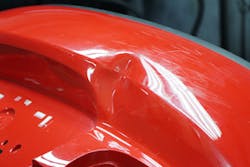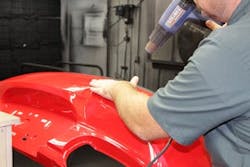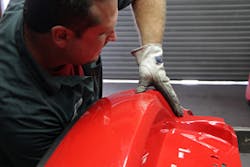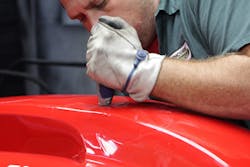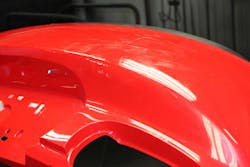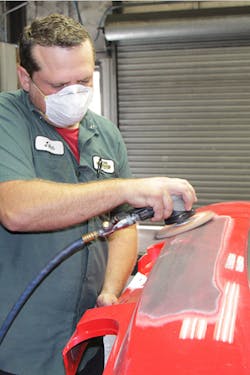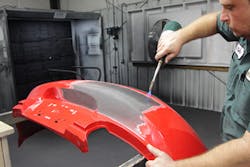This article has been updated from its 2016 version.
Content brought to you by ABRN. To subscribe click here.
Over the years, automakers have made numerous manufacturing changes to plastic bumper covers. In the beginning, they used urethane-coated steel; they then progressed to using only thermoset urethane. To save cost, there was a shift away from using high-priced urethane to less expensive thermoplastics like polycarbonate, TPO and polypropylene. As time passed, TPO and polypropylene became the clear leading materials because of cost and durability.
Some OEMs like Chevrolet, Mercedes Benz and Dodge still use polyurethane on lower production models. The new Dodge Challenger and Charger started life using urethane bumpers, but even those models on the 2014 and 2015s have switched to polypropylene. The current trend is to make more bumper covers out of polypropylene and make the covers progressively thinner, saving even more material cost. While this may sound like a bad thing for durability, the benefit to the technician is that 95 percent of the cars in the shop will use the same type of polypropylene bumper covers and all of them use the same repair techniques and materials.
A common repair to polypropylene bumpers is dent removal. While some say it’s impossible to do perfectly, it is not. Heating the bumper to the correct temperature is the key to dent removal. It’s very important to know that overheating or underheating the plastic will make dent removal much more difficult. When a plastic bumper is dented, the plastic becomes very stressed. Not only is it stressed in the dented area, but all around it, too. All of the stresses need to be released in order to remove the dent correctly; the only way to do this is with the correct amount of heat and pressure in the right areas.
Using the right heat for dent repair
By using the correct amount of heat and pressure, it is possible to reshape the bumper without causing more damage to it. Applying the correct amount of heat in the right area makes all the difference. While focusing the majority of the heat on the dent itself, you will also need to heat four to six inches around the dent. In doing so, you are relaxing the plastic, releasing the tension and pressure on the surrounding area caused by the impact.
When heating the area using a heat gun, keep the nozzle close to the surface to maintain control of what is heated and what isn’t. Be sure to keep the gun moving steadily at a moderate pace to allow the plastic to heat thoroughly without melting the surface or cause the paint to bubble. It is important to make sure you get the plastic very hot to the touch, but not so hot that it begins to sag. You will know you’ve reached the right temperature when it is too hot to touch with your bare hand for more than a second or two. At this temperature, the plastic can be reshaped with moderate pressure.
On one end of the spectrum, if the plastic isn’t hot enough, the damaged area can’t relax, and it will tend to spring back to its damaged form. On the other hand, if you overheat the plastic, it will become much more difficult to repair due to distortion and will tend to overstretch when being reshaped. With that being said, you would much rather work on the cool side than overheat it.
You can always reheat the bumper to achieve the temperature needed, but once its overheated there is no going back.
Overheating the plastic is the single worst thing you can do when trying to remove dents. Once the plastic has been overheated, the strength and flexibility have been compromised, making it much more difficult to reshape. Also, once it melts and cools back down, it becomes more brittle than the rest of the bumper. Working a dent in hardened, brittle plastic can cause it to crack and split easily, making more damage than you had to begin with, which reduces the profitability of an otherwise easy repair.
There are cases where overheating a bumper may be necessary in order to remove creases or kinks, so more care must be taken while reshaping it to minimize the amount of time and the amount of filler needed.
Selecting the right dent-removal tool
Once you have reached the temperature you feel is needed to reshape the damaged area, it is a simple matter of choosing the right tool to do the manipulating. For larger dents and to fix some minor waves, the palm of a gloved hand works well. For sharper dents, or to recreate body lines, a block of wood or the handle of a utility knife may be the best tool. Popping the dent sometimes requires straight steady pressure; other times firm lateral movement with a tool work the best. How you remove a dent is as complex or as simple as you make it.
When pushing a dent out, it helps to know where to start. It’s best to start at the outer area of the dent and work your way in towards the deepest part. This will release the pressure evenly, helping the worst part of the dent release easier.
Of course, some dents are easier to remove than others and some will require very little sanding and no filler before going to paint; others require a bit more work. When it comes to sanding, don’t be afraid to use aggressive sandpaper — like 80 grit or lower — to remove the paint and sand down the high spots. Save the fine grit paper like 180 and 320 for getting rid of the coarse sand scratches and fuzz that the aggressive sandpaper left behind. Being shy with the sandpaper will make removing high and low spots difficult. Once contoured and sanded with fine grit sandpaper, you can use a butane torch to get rid of the last little bit of fuzz. When using a torch to remove fuzz off raw plastic, keep it moving quickly while being careful to not overheat the bumper.
If you keep these few things in mind while removing a dent in a plastic bumper, you should be able to make a high-quality repair quickly, without causing additional damage to the bumper.
Be aware of the thickness of the plastic before you begin and take that into account when heating the dented area. Make sure you heat all around the dent, relieving all the stress to the entire area and not just to the dent. Remember to start removing a dent from the outside edges working toward the center and don’t be afraid to use aggressive sandpaper. Getting rid of pesky sand scratches and fuzz is a small price to pay to be able to get the job done quickly.
Don’t be afraid to try different tools and techniques; be creative. The worst that can happen is that the customer will need a new bumper cover, which is what they would need if you didn’t make the attempt. You will find that most dents can be repaired and repairing bumpers will make the shop more money than replacing a bumper. Repairing dents will keep the repair dollars in house, rather than giving those dollars to an OEM for a new cover. The best way to learn is to not be intimidated by the process and get out and try it. In no time, you will be an expert with the ability to generate more money for the shop.
Information supplied by Polyvance.
